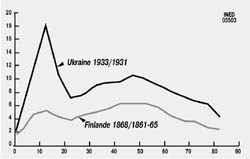The life expectancy of Ukrainians in 1933 was 7.3 and 10.9 years for men and women respectively

The guests warned from the very beginning that they were not going to pass a political judgment on Ukraine’s demographic catastrophes. Their goal is to show — by means of figures and graphs — the true situation in which Ukrainians were in the past and are now. “As citizens, not as scientists,” says Jacques Vallin, “we can make a conclusion that an extremely high mortality in the 1930s was not caused by natural factors, as was the case, say, in Finland in 1868. This means the famine was provoked to a larger extent by the authorities’ policies. But we cannot make such conclusions exclusively on the basis of statistical data.”
The French researchers managed to trace and thoroughly study some archive-stored statistical materials. They say today that, for the well-known reasons, it was a far from easy task. Mr. Vallin does not rule out that the demographers who supplied the then authorities with true information were subsequently destroyed. Moreover, the Frenchmen had to refer to the results of the 1926 and 1939 censuses (29 and 30.9 million, respectively), while the period between 1932 and 1939 remained, in terms of statistics, a blank spot. Nevertheless, the obtained results can be aptly called a sensation. The researchers came to a conclusion that life expectancy of the Ukrainians in 1933 was 7.3 and 10.9 years for men and women respectively. According to Serhiy Pirozhkov, such indices have not been recorded anywhere throughout human history. Moreover, it is primarily children and young people who were dying in the 1930s: the French authors claim that the peak age was between ten and twenty years. The famine took the heaviest toll of rural residents, which is little wonder, since peasants accounted for 80% of Ukraine’s population at the time.
The French demographers conclude that Ukraine lost 4.6 million people in 1932-1933. The researchers took into account not only the mortality rate of 2.6 million but also the declining birth rate and the index of migration. The famine was the reason why one million children were not born in Ukraine. The book authors also took account of forcible migration, estimated at 0.9 million people, and GULAG statistics because they claim there could be no spontaneous resettlement of Ukrainians at the time due to objective reasons.
The French authors do not rule out that the 2.6 million is an underrated mortality rate, for today’s estimates place the number of famine victims at 4.5-5 million. The 1930s statistics were partly doctored, following the governmental ban on recording the death of babies under one year of age by local administrations.
It should be noted that the research produced unexpected results not only with respect to the 1930s. The French demographers estimate that World War II, Stalinist repressions, the 1947 famine, as well as the overall quality of life, claimed a total 12.6 million lives. “But for the demographic catastrophe, the then Ukraine would have had a population of 48.3 million instead of 35.7 million,” Mr. Vallin says. Asked why the postwar period took a three times heavier toll than the 1930s famine, the experts said the root cause was the longer duration of that period. During that period, 7.1 million people died, 3.5 million were never born, and two million migrated.
In the experts’ view, Ukraine still feels the consequences of the 1930s and 1940s. Those events affected, above all, such things as the nation’s health and gene pool. Still, Mr. Vallin does not rule out that in this case the cynical law of biology was at work: the survival of the fittest. It would be also wrong to say that the demographic situation in today’s Ukraine is good. France Mesle’s studies showed that, while in the 1960s the life expectancy of Ukrainians and Russians did not differ from that of the French, now there is a striking gap between the two. The only thing that can inspire optimism is the situation with newborns, Ms. Mesle believes. Otherwise, there are two main reasons why people do not live long in either Ukraine or Russia, that is, cardiovascular disease and violent death. The next cause is infectious disease, which, having left Western Europe for good, tend to return to Ukraine.
An upward demographic trend was discernible in the mid-1980s, when, according to Ms. Mesle, the anti-alcohol campaign brought down the incidence of cardiovascular ailments and the number of accidents. Yet, Gorbachev’s policy had a very short-lived effect because there were loopholes where people could buy liquor. So the results clearly show that banning alcoholic drinks is not the way to improve demographic indices.
The next several-years-long demographic abyss occurred in the early 1990s, when our independent state was adapting to the new conditions of life. Following a period of some improvement, the latest data (as of 2000) again show a setback. The point is that, as Ms. Mesle explained, treatment for cardiac pathologies has improved in Western Europe. Moreover, Ukrainians and Russians care a lot less about their health than, say, the French do. This in part follows from “the lack of a sound public health policy and strategy in your country.” According to the demographer, while such Eastern European countries as Poland, the Czech Republic, and Hungary are already making strides toward a Western-style model of public health, Ukraine and Russia take no radical actions.
“What can be advised in this case? There probably is no panacea,” France Mesle muses. In her opinion, the first thing to do is improve the health of Ukrainians. For example, active antismoking campaigns have already produced an effect in the countries of Western Europe. For example, Poland is now working on a menu of its own: it is making efforts to cut the consumption of animal fats largely responsible for the growth of cardiovascular diseases.






